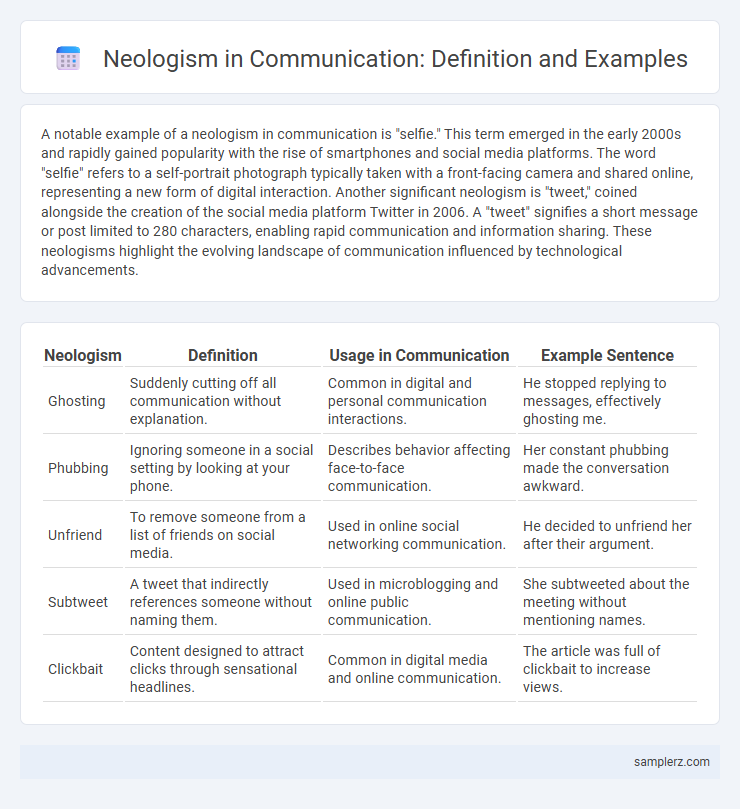A notable example of a neologism in communication is "selfie." This term emerged in the early 2000s and rapidly gained popularity with the rise of smartphones and social media platforms. The word "selfie" refers to a self-portrait photograph typically taken with a front-facing camera and shared online, representing a new form of digital interaction. Another significant neologism is "tweet," coined alongside the creation of the social media platform Twitter in 2006. A "tweet" signifies a short message or post limited to 280 characters, enabling rapid communication and information sharing. These neologisms highlight the evolving landscape of communication influenced by technological advancements.
Table of Comparison
| Neologism | Definition | Usage in Communication | Example Sentence |
|---|---|---|---|
| Ghosting | Suddenly cutting off all communication without explanation. | Common in digital and personal communication interactions. | He stopped replying to messages, effectively ghosting me. |
| Phubbing | Ignoring someone in a social setting by looking at your phone. | Describes behavior affecting face-to-face communication. | Her constant phubbing made the conversation awkward. |
| Unfriend | To remove someone from a list of friends on social media. | Used in online social networking communication. | He decided to unfriend her after their argument. |
| Subtweet | A tweet that indirectly references someone without naming them. | Used in microblogging and online public communication. | She subtweeted about the meeting without mentioning names. |
| Clickbait | Content designed to attract clicks through sensational headlines. | Common in digital media and online communication. | The article was full of clickbait to increase views. |
Introduction to Neologisms in Modern Communication
Neologisms such as "ghosting" and "finsta" have emerged as key terms reflecting evolving communication behaviors in digital spaces. These newly coined words capture specific social phenomena, enabling more precise expression and understanding in online interactions. The rapid adoption of neologisms highlights the dynamic nature of language adaptation driven by technological advancements.
The Role of Neologisms in Digital Language
Neologisms such as "ghosting," "selfie," and "subtweet" have reshaped digital communication by encapsulating complex social behaviors into concise terms. These new words enhance clarity and efficiency in online interactions across platforms like social media, instant messaging, and texting. The rapid creation and adoption of neologisms reflect evolving cultural trends and technological advancements in digital language.
Social Media as a Breeding Ground for New Words
Social media platforms such as Twitter, Instagram, and TikTok accelerate the creation and spread of neologisms like "ghosting," "finsta," and "clout." These new terms encapsulate evolving digital behaviors and social interactions unique to online communities. The rapid adoption of neologisms demonstrates how social media functions as a dynamic linguistic ecosystem, continually shaping modern communication.
Popular Neologisms Shaping Everyday Conversations
Popular neologisms such as "ghosting," "selfie," and "meme" have revolutionized everyday conversations by encapsulating complex social behaviors and digital culture within single terms. These words rapidly gain traction through social media platforms, reflecting evolving norms in interpersonal communication and online interaction. Their widespread usage highlights the dynamic nature of language adapting to technological advancements and contemporary social experiences.
Tech-Driven Neologisms: Impact on Communication
Tech-driven neologisms like "selfie," "emoji," and "unfriend" have revolutionized digital communication by introducing concise, widely understood terms that enhance online interaction. These neologisms reflect evolving social behaviors and technology integration, facilitating more expressive and efficient exchanges across social media platforms. Their rapid adoption underscores the dynamic relationship between technology innovation and language evolution in shaping contemporary communication.
Neologisms in Youth and Pop Culture Speech
Neologisms in youth and pop culture speech, such as "stan" (meaning an obsessive fan) and "ghosting" (suddenly cutting off communication), reflect evolving digital communication trends and social behaviors. These terms often originate from social media platforms, quickly spreading through memes, music, and online communities, shaping contemporary vernacular. The rapid adoption of such neologisms demonstrates how language dynamically adapts to technological influence and cultural shifts among younger generations.
Business Communication and Industry-Specific Neologisms
In business communication, neologisms such as "synergize" and "pivot" have become integral, reflecting dynamic strategies and adaptability in corporate environments. Industry-specific terms like "fintech" in finance or "biotech" in pharmaceuticals enable precise and efficient dialogue among professionals. These neologisms enhance clarity and foster innovation by encapsulating complex concepts into concise, widely understood terminology.
The Spread of Neologisms Across Global Languages
Neologisms like "selfie," originating from English social media culture, rapidly permeate global languages due to digital communication platforms. The widespread adoption of these terms illustrates the influence of internet discourse and intercultural exchange in evolving contemporary vocabulary. This phenomenon highlights the dynamic nature of linguistic innovation driven by real-time, borderless communication networks.
Challenges of Understanding New Words in Communication
Neologisms like "ghosting" and "doomscrolling" present challenges in communication as their meanings may be unfamiliar to different audiences, leading to misunderstandings. These new terms often evolve rapidly within digital and social media contexts, creating gaps in comprehension between generations or cultural groups. Effective communication requires clarifying unfamiliar neologisms to ensure accurate message interpretation.
Future Trends: The Evolution of Neologisms in Communication
Neologisms like "deepfake" and "finfluencer" showcase how emerging technologies and digital platforms shape language evolution in communication. These terms reflect advancements in artificial intelligence and social media, signaling future trends where neologisms will continue to evolve alongside innovation. Understanding these dynamic linguistic changes is crucial for effective communication in rapidly transforming digital landscapes.

example of neologism in communication Infographic
 samplerz.com
samplerz.com